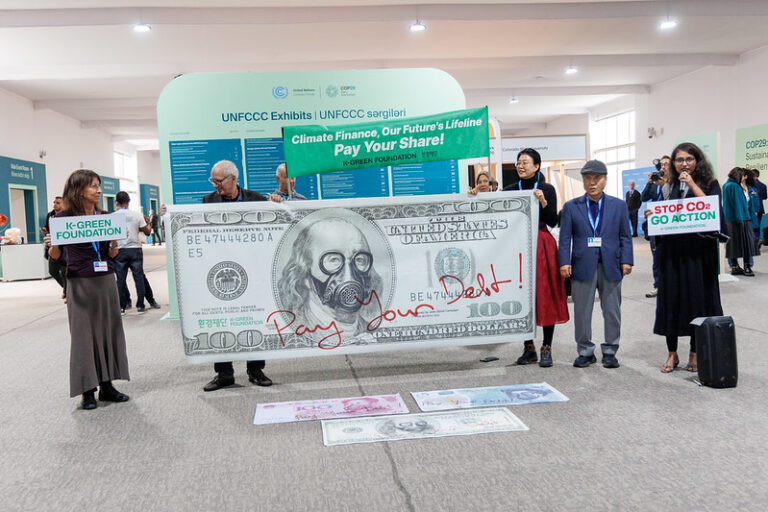If we can’t count the money, how can we measure the impact of international climate finance?

Sylvan Lutz and Camila Cristancho Duarte highlight the urgent need for COP29’s New Collective Quantified Goal (NCQG) to establish clear standards, accountability and transparency to bridge the climate finance gap in developing countries and avoid the same lacklustre outcome of the original $100 billion commitment made in 2009.
In 2009, developed countries (donors) pledged $100 billion annually by 2020 in climate finance for developing nations (recipients). Over a decade later, inconsistent reporting and vague definitions obscure whether this target has been met, if the funding is additional, and whether it supports Paris Agreement goals.
The UN Environment Programme’s latest Emissions Gap and Adaptation Gap reports reveal a growing climate finance shortfall. The New Collective Quantified Goal (NCQG) on climate finance, currently under negotiation at COP29 in Baku, is an opportunity to address this issue. The first week of negotiations did not resolve the significant issues of the total climate finance amount, which countries should contribute or which should receive funds. This week, negotiators must also take steps to embed clarity, accountability and transparency into the NCQG framework.
The state of international climate finance
The $100 billion goal is now recognised as insufficient to close the mitigation and adaptation gaps by the Independent High-Level Expert Group on Climate Finance (IHLEG), with recent research also highlighting another troubling reality.
While OECD analysis suggests the goal was met in 2022 (two years later than the original target date), other research suggests it remains unmet. The United Nations Framework Convention on Climate Change (UNFCCC) Standing Committee on Finance finds that just $67.1 billion was reported by Annex II[i] donor countries in 2022. Applying a stricter definition of climate-relevant finance to the OECD data, Oxfam finds that only $28–35 billion was provided that same year.
These contrasting findings highlight a critical issue: the absence of clear and consistent criteria for defining ‘international climate finance’ (ICF) under the UNFCCC. Without standardised guidelines, it is challenging to assess whether donor countries’ contributions genuinely meet the $100 billion goal and provide funding that is additional to other aid commitments. This ambiguity also raises questions about the real impact of these funds in recipient countries.
While ICF is a small portion of total climate finance flows, it is vital for recipient countries. The Standing Committee on Finance’s data show that global climate finance flows averaged $1.3 trillion annually in 2021–2022, covering domestic public and private funding, cross-border private investments and ICF. The IHLEG projects that by 2030, developing countries (excluding China) will need up to $2.4 trillion annually to meet the Paris Agreement’s targets. Although the NCQG’s co-chairs have proposed $1–2 trillion per year in ICF as a baseline, even such an increase falls short of recipient countries’ needs. As the IHLEG emphasises, to close this gap, credible “country leadership will be crucial” to catalyse other forms of climate finance.
Future commitments for ICF risk repeating past shortcomings. A recent data publication by the Transition Pathway Initiative Centre for the Assessing Sovereign Climate Risks and Opportunities (ASCOR) project shows that most assessed donor countries’ post-2024 commitments are unclear and insufficient to meet even the current $100 billion goal.As the NCQG is negotiated, countries need to take accountability and credibility seriously.
The problem of credibility in climate finance
The first challenge is to determine how much each donor country should be expected to contribute. The UNFCCC finance goal aims to pool donor efforts without setting specific obligations for individual donor countries; it has no clear framework for proportioning contributions. Addressing this requires downscaling international commitments to the national level. Proposals from the World Resources Institute (WRI) and the Overseas Development Institute (ODI) offer contrasting methodologies: the WRI bases proportional contributions on a country’s gross domestic product, while ODI incorporates considerations of economic capacity and historical emissions to determine fair contributing shares of the $100 billion goal. The differences in proportioning methodologies underscore the uncertainty in the current UNFCCC framework about the expected sources and distribution of ICF. This ambiguity is reflected in ASCOR’s analysis, which found that only four of 21 assessed donor countries have credible, forward-looking commitments aligned with a proportional share of the $100 billion goal (using an adjusted version of WRI’s methodology on publicly-stated targets for future ICF contributions).
A second challenge is the lack of common understanding of ‘what counts as climate finance’. In the course of our ASCOR analysis, we found that donor countries’ ICF definitions vary widely in UNFCCC Biennial Reports (BRs). For instance, the Netherlands reports only disbursed grant-based finance, while Germany includes loans from state-run banks, and the UK reports only committed, not disbursed funds. The European Union’s annual reporting system is a bright spot with consistent information on publicly and privately mobilised finance. However, the country data reported on the EU system only covers EU countries and often differs from countries’ BRs and official press releases.
It is also unclear what exactly donor countries are contributing to. Our review found that while some countries (e.g. Germany) provided clear tagging on how the money was spent, others (e.g. the United States) provided few details beyond recipient region, amount and sector. Reuters has reported that donor countries have claimed ‘climate finance’ supported a hotel expansion in Haiti, a new coal plant in Bangladesh and an airport expansion in Egypt. While the donor countries named by Reuters defended their programmes, the current state of ICF definitions leaves donor countries free to claim a wide range of activities that only tenuously support the Paris Agreement goals and may not be additional to their other aid commitments.
Finally, even if the data is reliable, it is late. The BR and incoming Biennial Transparency Report (BTR) frameworks operate on a two-year-plus lag.
The lack of transparency and timeliness surrounding ICF undermines recipient countries’ ability to implement their current mitigation and adaptation strategies. It may also lead to limited ambition in the Nationally Determined Contributions (NDCs) submitted in the next round and hinder the mobilisation of additional private investment. Such mobilisation relies on clear policy signals and transparent data (along with other variables, such as the cost of capital and real or perceived risks in developing countries).
Lessons for the New Collective Quantified Goal
During the first week of NCQG negotiations, the co-chairs’ initial draft text was seen as unbalanced by donor and recipient countries. The new draft text is significantly longer, reflecting the diverse views of the negotiators and the lack of consensus on key issues. Despite these challenges, COP29 still offers an opportunity to reset credibility around ICF through clear donor commitments and transparent, consistent reporting. A failure to do so would undermine any numerical target that may be agreed to in Baku as well as the goals of the Paris Agreement.
The NCQG provisional outline includes possible criteria for the contributor base (donor countries). Ideally, it would also include clear commitments from donor countries regarding how much they will contribute and when. This would provide a foundation for recipient countries to plan national climate strategies and deliver a positive signal to private sector investors. Although agreeing on the design of such a proportioning mechanism will be challenging, the lack of one may be a significant factor in further under-contributions.
Determining what donor countries should pay for is and tracking those donations is equally important and remains a stumbling block in the UNFCCC negotiations. The Standing Committee on Finance has started to systemically track climate finance, but it notes in a recent report that the lack of a clear definition of climate finance is a significant limitation, even in the Enhanced Transparency Framework (ETF) and forthcoming BTR data. The Committee’s latest definition notes that climate finance should follow actions identified in a country’s NDC, national adaptation plan or other national planning documents.
Some options proposed in the NCQG draft text partially align with the Standing Committee’s new definition of climate finance and specify which sources of finance (grants, market-rate loans, concessional loans, private finance) should count towards the goal. However, it does not appear to lay the groundwork for defining what programmes and projects should be considered ‘climate-related’ or how to measure if it is additional to other development funding. To enhance the NCQG’s effectiveness, the definition of ICF should include what types of projects and programmes can receive funding. For example, it could build on precedents set in the recently published Article 6.4 Supervisory Body framework on tradeable emissions credits and focus on making national climate documents investable.
The NCQG framework must prioritise accountability. Only through transparent commitments, robust reporting practices and clear definitions can ICF provide developing countries with a reliable foundation and mobilise the private finance needed to achieve Paris Agreement goals.
Without a transparent proportioning mechanism and a coherent climate finance reporting framework, any new agreement risks the same lacklustre outcome as the original $100 billion commitment.
The authors would like to thank Eléonore Soubeyran, Antonina Scheer, Carmen Nuzzo, Georgina Kyriacou and Jodi-Ann Wang for their helpful reviews of this commentary.
Authors’ note on methodology
This commentary draws on research conducted for the recently released assessment of 70 countries’ climate performance by the Transition Pathway Initiative Centre (TPI Centre) based at the Grantham Research Institute on Climate Change and the Environment. The TPI Centre is the academic partner of the Assessing Sovereign Climate-Related Opportunities and Risks (ASCOR) project. Note that ASCOR only assesses Annex II countries to the UNFCCC for their international climate finance contributions.
This commentary contains information on the COP29 proceedings up to the morning of 19 November 2024.
[i] Annex II countries are: Australia, Austria, Belgium, Canada, Denmark, European Economic Community, Finland, France, Germany, Greece, Iceland, Ireland, Italy, Japan, Luxembourg, Netherlands, New Zealand, Norway, Portugal, Spain, Sweden, Switzerland, Turkey, United Kingdom of Great Britain and Northern Ireland, United States of America.

